HONDA CIVIC HYBRID 2015 9.G Quick Guide
Manufacturer: HONDA, Model Year: 2015, Model line: CIVIC HYBRID, Model: HONDA CIVIC HYBRID 2015 9.GPages: 65, PDF Size: 3.32 MB
Page 11 of 65
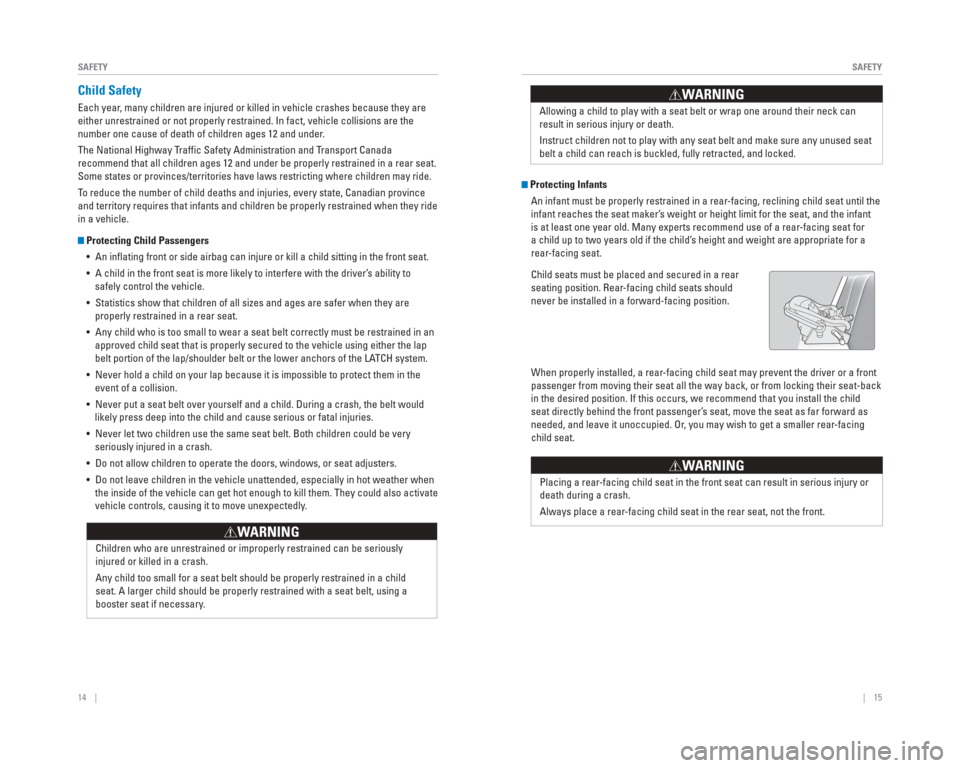
14 || 15
SAFETY
SAFETY
Child Safety
Each year, many children are injured or killed in vehicle crashes because they ar\
e
either unrestrained or not properly restrained. In fact, vehicle collisi\
ons are the
number one cause of death of children ages 12 and under.
The National Highway Traffi c Safety Administration and Transport Canada
recommend that all children ages 12 and under be properly restrained in \
a rear seat.
Some states or provinces/territories have laws restricting where childre\
n may ride.
To reduce the number of child deaths and injuries, every state, Canadian \
province
and territory requires that infants and children be properly restrained \
when they ride
in a vehicle.
Protecting Child Passengers
• An infl ating front or side airbag can injure or kill a child sitting in the fro\
nt seat.
• A child in the front seat is more likely to interfere with the driver’\
s ability to safely control the vehicle.
• Statistics show that children of all sizes and ages are safer when they \
are properly restrained in a rear seat.
• Any child who is too small to wear a seat belt correctly must be restrai\
ned in an approved child seat that is properly secured to the vehicle using either\
the lap
belt portion of the lap/shoulder belt or the lower anchors of the LATCH system.
• Never hold a child on your lap because it is impossible to protect them \
in the event of a collision.
• Never put a seat belt over yourself and a child. During a crash, the bel\
t would likely press deep into the child and cause serious or fatal injuries.
• Never let two children use the same seat belt. Both children could be ve\
ry seriously injured in a crash.
• Do not allow children to operate the doors, windows, or seat adjusters.
• Do not leave children in the vehicle unattended, especially in hot weath\
er when the inside of the vehicle can get hot enough to kill them. They could al\
so activate
vehicle controls, causing it to move unexpectedly.
Children who are unrestrained or improperly restrained can be seriously \
injured or killed in a crash.
Any child too small for a seat belt should be properly restrained in a c\
hild
seat. A larger child should be properly restrained with a seat belt, usi\
ng a
booster seat if necessary.
WARNING
Protecting Infants An infant must be properly restrained in a rear-facing, reclining child seat until the
infant reaches the seat maker’s weight or height limit for the seat, and the infant
is at least one year old. Many experts recommend use of a rear-facing seat for
a child up to two years old if the child’s height and weight are appropriate for a
rear-facing seat.
Child seats must be placed and secured in a rear
seating position. Rear-facing child seats should
never be installed in a forward-facing position.
When properly installed, a rear-facing child seat may prevent the driver or a front
passenger from moving their seat all the way back, or from locking their\
seat-back
in the desired position. If this occurs, we recommend that you install t\
he child
seat directly behind the front passenger’s seat, move the seat as far forward as
needed, and leave it unoccupied. Or, you may wish to get a smaller rear-facing
child seat.
Placing a rear-facing child seat in the front seat can result in serious injury or
death during a crash.
Always place a rear-facing child seat in the rear seat, not the front.
WARNING
Allowing a child to play with a seat belt or wrap one around their neck \
can
result in serious injury or death.
Instruct children not to play with any seat belt and make sure any unuse\
d seat
belt a child can reach is buckled, fully retracted, and locked.
WARNING
Page 12 of 65
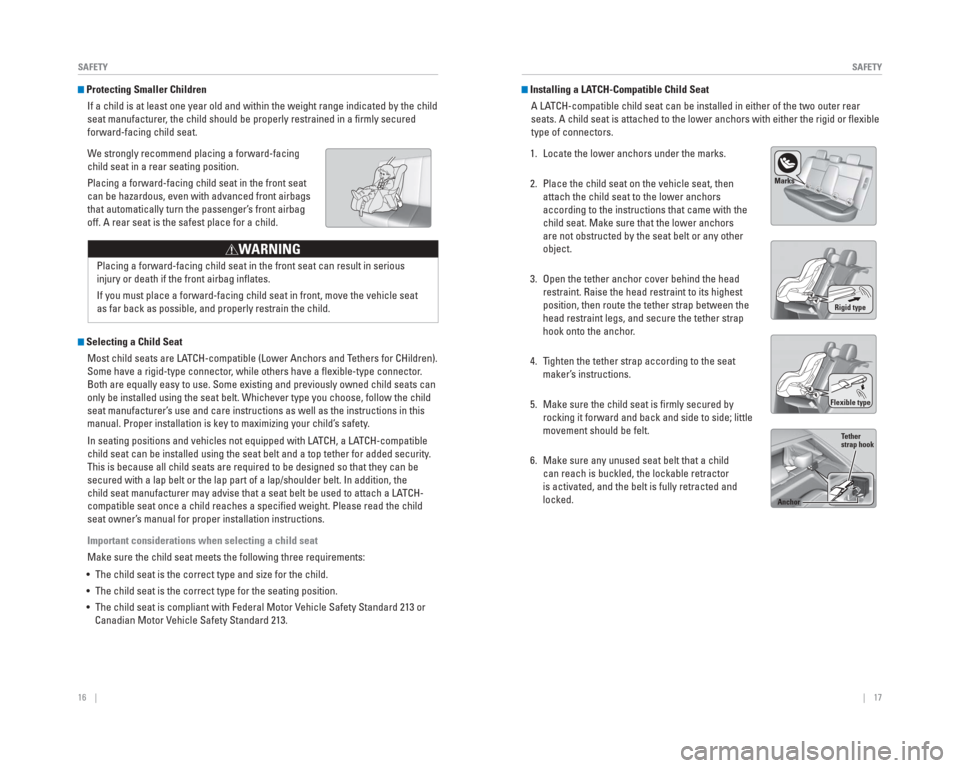
16 || 17
SAFETY
SAFETY
Protecting Smaller Children
If a child is at least one year old and within the weight range indicate\
d by the child
seat manufacturer, the child should be properly restrained in a fi rmly secured
forward-facing child seat.
We strongly recommend placing a forward-facing
child seat in a rear seating position.
Placing a forward-facing child seat in the front seat
can be hazardous, even with advanced front airbags
that automatically turn the passenger’s front airbag
off. A rear seat is the safest place for a child.
Selecting a Child SeatMost child seats are LATCH-compatible (Lower Anchors and Tethers for CHildren).
Some have a rigid-type connector, while others have a fl exible-type connector.
Both are equally easy to use. Some existing and previously owned child s\
eats can
only be installed using the seat belt. Whichever type you choose, follow\
the child
seat manufacturer’s use and care instructions as well as the instructions in this
manual. Proper installation is key to maximizing your child’s safety.
In seating positions and vehicles not equipped with LATCH, a LATCH-compatible
child seat can be installed using the seat belt and a top tether for add\
ed security.
This is because all child seats are required to be designed so that they\
can be
secured with a lap belt or the lap part of a lap/shoulder belt. In addit\
ion, the
child seat manufacturer may advise that a seat belt be used to attach a \
LATCH-
compatible seat once a child reaches a specifi ed weight. Please read the child
seat owner’s manual for proper installation instructions.
Important considerations when selecting a child seat
Make sure the child seat meets the following three requirements:
• The child seat is the correct type and size for the child.
• The child seat is the correct type for the seating position.
• The child seat is compliant with Federal Motor Vehicle Safety Standard 213 or Canadian Motor Vehicle Safety Standard 213.
Placing a forward-facing child seat in the front seat can result in seri\
ous
injury or death if the front airbag infl ates.
If you must place a forward-facing child seat in front, move the vehicle\
seat
as far back as possible, and properly restrain the child.
W ARNING
Installing a LATCH-Compatible Child Seat
A LATCH-compatible child seat can be installed in either of the two outer re\
ar
seats. A child seat is attached to the lower anchors with either the rig\
id or fl exible
type of connectors.
1. Locate the lower anchors under the marks.
2. Place the child seat on the vehicle seat, then attach the child seat to the lower anchors
according to the instructions that came with the
child seat. Make sure that the lower anchors
are not obstructed by the seat belt or any other
object.
3. Open the tether anchor cover behind the head restraint. Raise the head restraint to its highest
position, then route the tether strap between the
head restraint legs, and secure the tether strap
hook onto the anchor.
4. Tighten the tether strap according to the seat maker’s instructions.
5. Make sure the child seat is fi rmly secured by rocking it forward and back and side to side; little
movement should be felt.
6. Make sure any unused seat belt that a child can reach is buckled, the lockable retractor
is activated, and the belt is fully retracted and
locked.
Marks
Rigid type
Flexible type Tether
strap hook
Anchor
Page 13 of 65
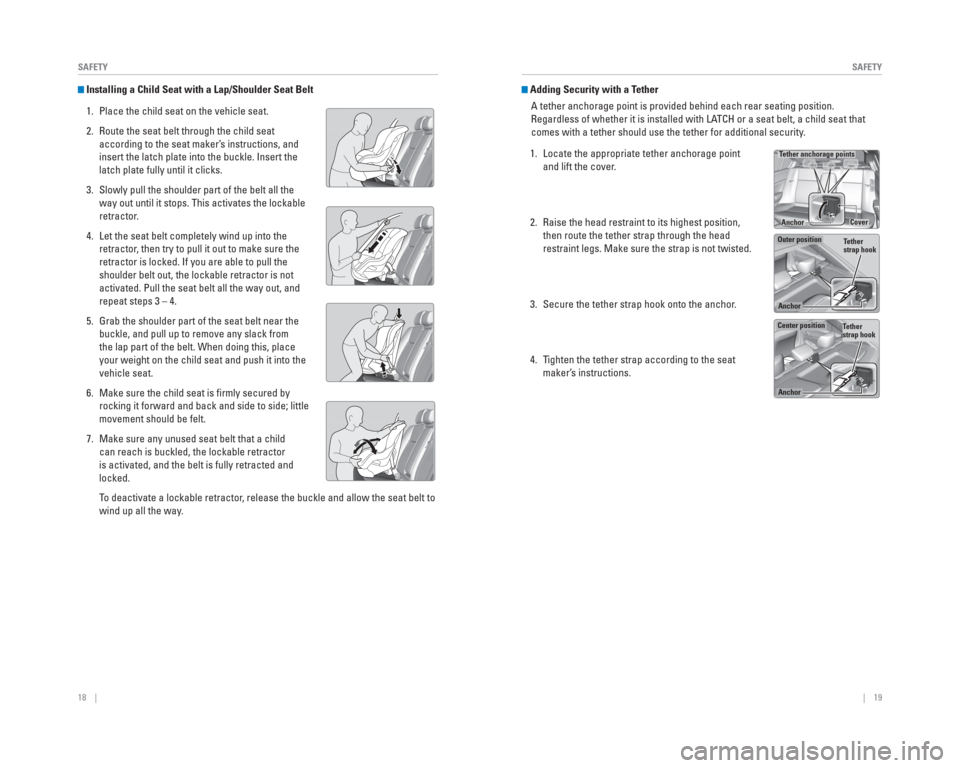
18 || 19
SAFETY
SAFETY
Installing a Child Seat with a Lap/Shoulder Seat Belt
1. Place the child seat on the vehicle seat.
2. Route the seat belt through the child seat according to the seat maker’s instructions, and
insert the latch plate into the buckle. Insert the
latch plate fully until it clicks.
3. Slowly pull the shoulder part of the belt all the way out until it stops. This activates the lockable
retractor.
4. Let the seat belt completely wind up into the retractor, then try to pull it out to make sure the
retractor is locked. If you are able to pull the
shoulder belt out, the lockable retractor is not
activated. Pull the seat belt all the way out, and
repeat steps 3 – 4.
5. Grab the shoulder part of the seat belt near the buckle, and pull up to remove any slack from
the lap part of the belt. When doing this, place
your weight on the child seat and push it into the
vehicle seat.
6. Make sure the child seat is fi rmly secured by rocking it forward and back and side to side; little
movement should be felt.
7. Make sure any unused seat belt that a child can reach is buckled, the lockable retractor
is activated, and the belt is fully retracted and
locked.
To deactivate a lockable retractor, release the buckle and allow the seat belt to wind up all the way. Adding Security with a Tether
A tether anchorage point is provided behind each rear seating position. \
Regardless of whether it is installed with LATCH or a seat belt, a child seat that
comes with a tether should use the tether for additional security.
1. Locate the appropriate tether anchorage point and lift the cover.
2. Raise the head restraint to its highest position, then route the tether strap through the head
restraint legs. Make sure the strap is not twisted.
3. Secure the tether strap hook onto the anchor.
4. Tighten the tether strap according to the seat maker’s instructions.
Tether anchorage points
Anchor
Outer position
Center position Anchor
Anchor Cover
T ether
strap hook
T ether
strap hook
Page 14 of 65
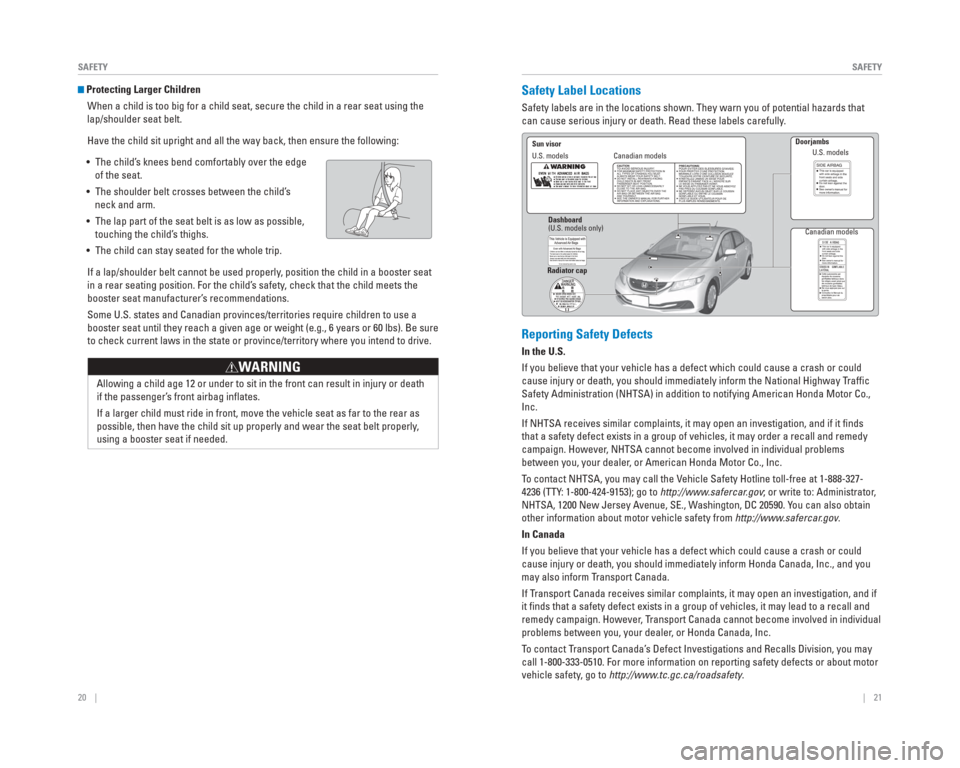
20 || 21
SAFETY
SAFETY
Protecting Larger Children
When a child is too big for a child seat, secure the child in a rear sea\
t using the
lap/shoulder seat belt.
Have the child sit upright and all the way back, then ensure the followi\
ng:
• The child’s knees bend comfortably over the edge of the seat.
• The shoulder belt crosses between the child’s neck and arm.
• The lap part of the seat belt is as low as possible, touching the child’s thighs.
• The child can stay seated for the whole trip.
If a lap/shoulder belt cannot be used properly, position the child in a booster seat
in a rear seating position. For the child’s safety, check that the child meets the
booster seat manufacturer’s recommendations.
Some U.S. states and Canadian provinces/territories require children to \
use a
booster seat until they reach a given age or weight (e.g., 6 years or 6\
0 lbs). Be sure
to check current laws in the state or province/territory where you inten\
d to drive.
Allowing a child age 12 or under to sit in the front can result in injur\
y or death
if the passenger’s front airbag infl ates.
If a larger child must ride in front, move the vehicle seat as far to th\
e rear as
possible, then have the child sit up properly and wear the seat belt pro\
perly,
using a booster seat if needed.
WARNING
Safety Label Locations
Safety labels are in the locations shown. They warn you of potential haz\
ards that
can cause serious injury or death. Read these labels carefully.
Sun visor
U.S. models Canadian models
Dashboard
(U.S. models only)
Radiator cap Doorjambs
U.S. models
Canadian models
Reporting Safety Defects
In the U.S.
If you believe that your vehicle has a defect which could cause a crash \
or could
cause injury or death, you should immediately inform the National Highwa\
y T raffi c
Safety Administration (NHTSA) in addition to notifying American Honda \
Motor Co.,
Inc.
If NHTSA receives similar complaints, it may open an investigation, and \
if it fi nds
that a safety defect exists in a group of vehicles, it may order a recal\
l and remedy
campaign. However , NHTSA cannot become involved in individual problems
between you, your dealer , or American Honda Motor Co., Inc.
T o contact NHTSA, you may call the V ehicle Safety Hotline toll-free at 1-888-327-
4236 (TTY : 1-800-424-9153); go to http://www .safercar.gov; or write to: Administrator ,
NHTSA, 1200 New Jersey A venue, SE., Washington, DC 20590. Y ou can also obtain
other information about motor vehicle safety from http://www .safercar.gov.
In Canada
If you believe that your vehicle has a defect which could cause a crash \
or could
cause injury or death, you should immediately inform Honda Canada, Inc.,\
and you
may also inform T ransport Canada.
If T ransport Canada receives similar complaints, it may open an investigatio\
n, and if
it fi nds that a safety defect exists in a group of vehicles, it may lead to a\
recall and
remedy campaign. However , Transport Canada cannot become involved in individual
problems between you, your dealer , or Honda Canada, Inc.
T o contact T ransport Canada’ s Defect Investigations and Recalls Division, you may
call 1-800-333-0510. For more information on reporting safety defects or\
about motor
vehicle safety , go to http://www .tc.gc.ca/roadsafety.
Page 15 of 65
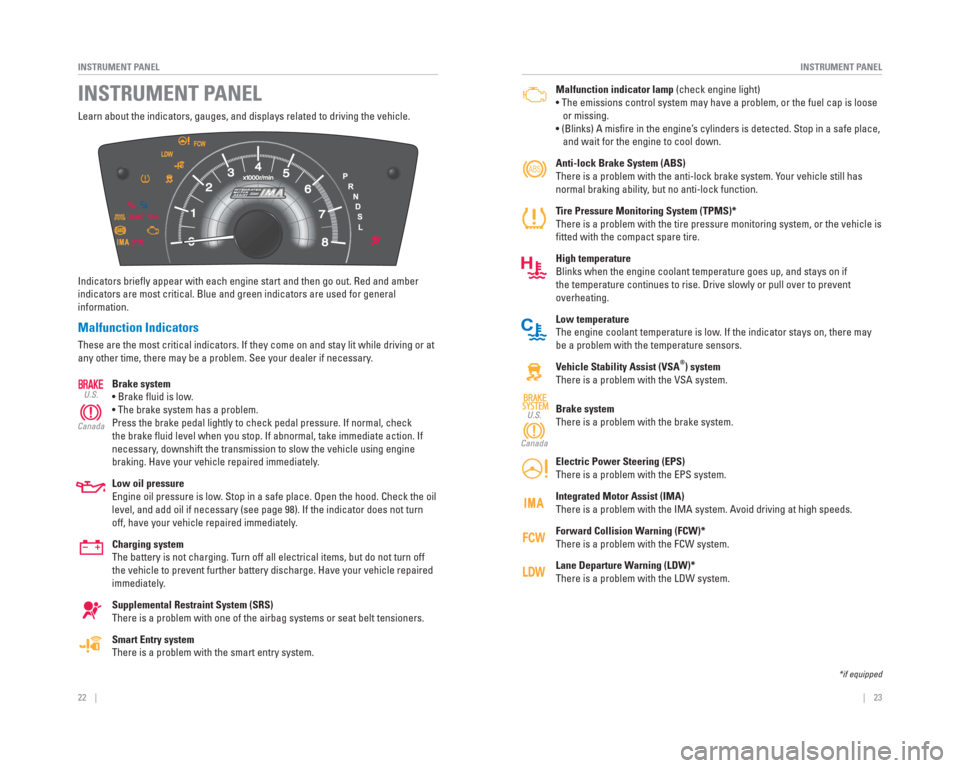
22 || 23
INSTRUMENT PANEL
INSTRUMENT PANEL
Learn about the indicators, gauges, and displays related to driving the \
vehicle.
Indicators briefl y appear with each engine start and then go out. Red and amber
indicators are most critical. Blue and green indicators are used for gen\
eral
information.
Malfunction Indicators
These are the most critical indicators. If they come on and stay lit whi\
le driving or at
any other time, there may be a problem. See your dealer if necessary.
Brake system
• Brake fl uid is low.
• The brake system has a problem.
Press the brake pedal lightly to check pedal pressure. If normal, check \
the brake fl uid level when you stop. If abnormal, take immediate action. If
necessary, downshift the transmission to slow the vehicle using engine
braking. Have your vehicle repaired immediately.
Low oil pressure
Engine oil pressure is low. Stop in a safe place. Open the hood. Check the oil
level, and add oil if necessary (see page 98). If the indicator does n\
ot turn
off, have your vehicle repaired immediately.
Charging system
The battery is not charging. Turn off all electrical items, but do not turn off
the vehicle to prevent further battery discharge. Have your vehicle repa\
ired
immediately.
Supplemental Restraint System (SRS)
There is a problem with one of the airbag systems or seat belt tensioner\
s.
Smart Entry system
There is a problem with the smart entry system.
U.S.
Canada
INSTRUMENT PANEL Malfunction indicator lamp (check engine light)
• The emissions control system may have a problem, or the fuel cap is\
loose
or missing.
• (Blinks) A misfi re in the engine’s cylinders is detected. Stop in a safe place,
and wait for the engine to cool down.
Anti-lock Brake System ( ABS)
There is a problem with the anti-lock brake system. Your vehicle still has
normal braking ability, but no anti-lock function.
Tire Pressure Monitoring System ( TPMS)*
There is a problem with the tire pressure monitoring system, or the vehi\
cle is
fi tted with the compact spare tire.
High temperature
Blinks when the engine coolant temperature goes up, and stays on if
the temperature continues to rise. Drive slowly or pull over to prevent \
overheating.
Low temperature
The engine coolant temperature is low. If the indicator stays on, there may
be a problem with the temperature sensors.
Vehicle Stability Assist ( VSA
®) system
There is a problem with the VSA system.
Brake system
There is a problem with the brake system.
Electric Power Steering (EPS)
There is a problem with the EPS system.
Integrated Motor Assist ( IMA)
There is a problem with the IMA system. Avoid driving at high speeds.
Forward Collision Warning (FCW)*
There is a problem with the FCW system.
Lane Departure Warning (LDW)*
There is a problem with the LDW system.
SYSTEMSYSTEMU.S.
Canada
*if equipped
Page 16 of 65
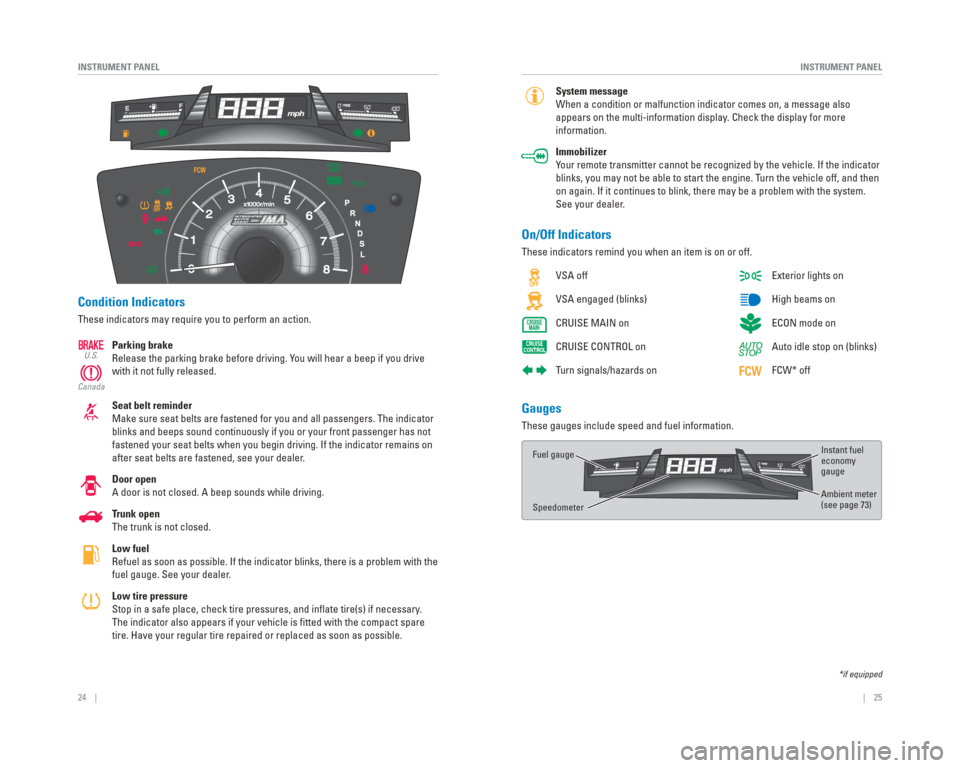
24 || 25
INSTRUMENT PANEL
INSTRUMENT PANEL
Condition Indicators
These indicators may require you to perform an action.
Parking brake
Release the parking brake before driving. You will hear a beep if you drive
with it not fully released.
Seat belt reminder
Make sure seat belts are fastened for you and all passengers. The indica\
tor
blinks and beeps sound continuously if you or your front passenger has n\
ot
fastened your seat belts when you begin driving. If the indicator remain\
s on
after seat belts are fastened, see your dealer.
Door open
A door is not closed. A beep sounds while driving.
Trunk open
The trunk is not closed.
Low fuel
Refuel as soon as possible. If the indicator blinks, there is a problem \
with the
fuel gauge. See your dealer.
Low tire pressure
Stop in a safe place, check tire pressures, and infl ate tire(s) if necessary.
The indicator also appears if your vehicle is fi tted with the compact spare
tire. Have your regular tire repaired or replaced as soon as possible.
U.S.
Canada
System message
When a condition or malfunction indicator comes on, a message also
appears on the multi-information display. Check the display for more
information.
Immobilizer
Your remote transmitter cannot be recognized by the vehicle. If the indic\
ator
blinks, you may not be able to start the engine. Turn the vehicle off, and then
on again. If it continues to blink, there may be a problem with the syst\
em.
See your dealer.
On/Off Indicators
These indicators remind you when an item is on or off.
Gauges
These gauges include speed and fuel information. VSA off
VSA engaged (blinks)
CRUISE MAIN on
CRUISE CONTROL on
Turn signals/hazards on
*if equipped
Exterior lights on
High beams on
ECON mode on
Auto idle stop on (blinks)
FCW* off
Instant fuel
economy
gauge
Ambient meter
(see page 73)
Fuel gauge
Speedometer
Page 17 of 65
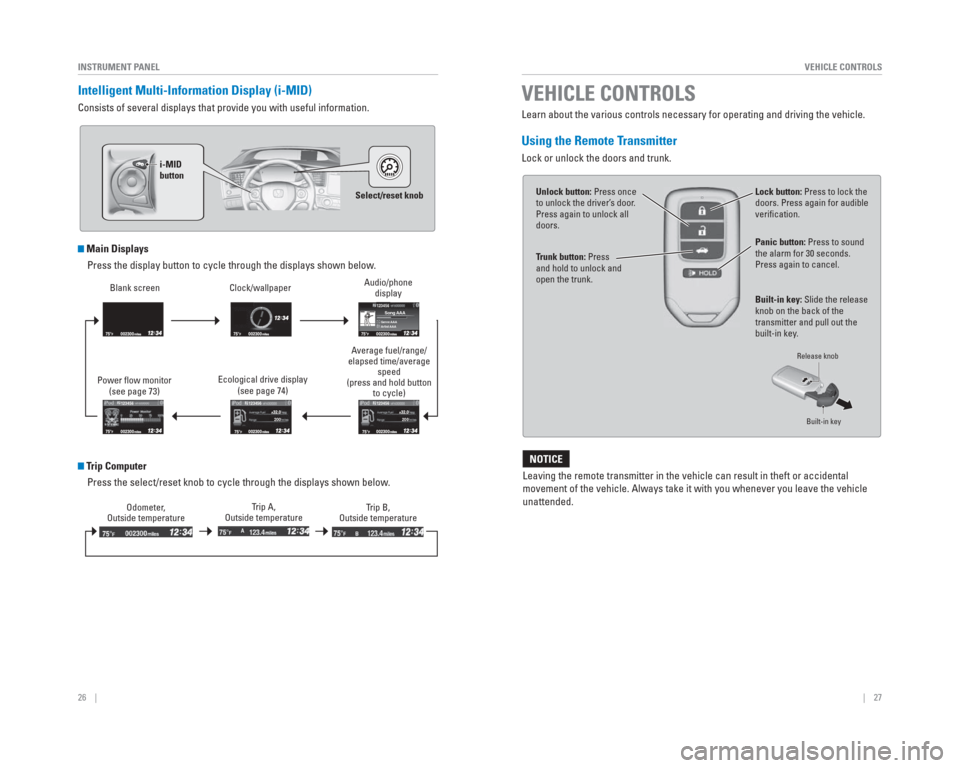
26 || 27
VEHICLE CONTROLS
INSTRUMENT PANEL
Intelligent Multi-Information Display ( i-MID)
Consists of several displays that provide you with useful information.
Main Displays
Press the display button to cycle through the displays shown below.
Trip ComputerPress the select/reset knob to cycle through the displays shown below.
Power fl ow monitor (see page 73) Clock/wallpaper
Blank screen
Average fuel/range/
elapsed time/average speed
(press and hold button to cycle)
Audio/phone
display
123456
20 0
123456
123456
Genr e AAASong AAA
Artist AAA
Odometer,
Outside temperature Trip A,
Outside temperature Trip B,
Outside temperature
Select/reset knob
i-MID
button
200
1
23456
Ecological drive display
(see page 74)
Learn about the various controls necessary for operating and driving the\
vehicle.
Using the Remote Transmitter
Lock or unlock the doors and trunk.
Leaving the remote transmitter in the vehicle can result in theft or acc\
idental
movement of the vehicle. Always take it with you whenever you leave the \
vehicle
unattended.
NOTICE
Unlock button: Press once
to unlock the driver’ s door.
Press again to unlock all
doors.
T runk button: Press
and hold to unlock and
open the trunk. Lock button: Press to lock the
doors. Press again for audible
verifi
cation.
Panic button: Press to sound
the alarm for 30 seconds.
Press again to cancel.
VEHICLE CONTROLS
Built-in key: Slide the release
knob on the back of the
transmitter and pull out the
built-in key .
Release knob
Built-in key
Page 18 of 65
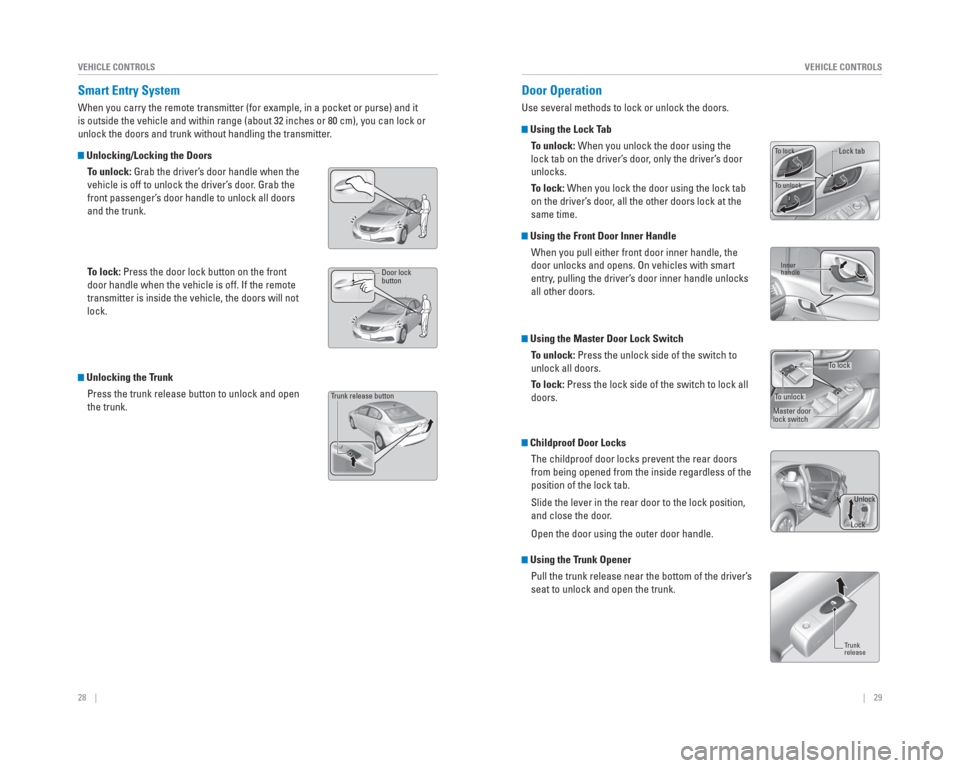
28 || 29
VEHICLE CONTROLS
VEHICLE CONTROLS
Smart Entry System
When you carry the remote transmitter (for example, in a pocket or purs\
e) and it
is outside the vehicle and within range (about 32 inches or 80 cm), yo\
u can lock or
unlock the doors and trunk without handling the transmitter.
Unlocking/Locking the Doors
To unlock: Grab the driver’s door handle when the
vehicle is off to unlock the driver’s door. Grab the
front passenger’s door handle to unlock all doors
and the trunk.
To lock: Press the door lock button on the front
door handle when the vehicle is off. If the remote
transmitter is inside the vehicle, the doors will not
lock.
Unlocking the TrunkPress the trunk release button to unlock and open
the trunk.
Door lock
button
T runk release button
Door Operation
Use several methods to lock or unlock the doors.
Using the Lock Tab
To unlock: When you unlock the door using the
lock tab on the driver’s door, only the driver’s door
unlocks.
To lock: When you lock the door using the lock tab
on the driver’s door, all the other doors lock at the
same time.
Using the Front Door Inner HandleWhen you pull either front door inner handle, the
door unlocks and opens. On vehicles with smart
entry, pulling the driver’s door inner handle unlocks
all other doors.
Using the Master Door Lock SwitchTo unlock: Press the unlock side of the switch to
unlock all doors.
To lock: Press the lock side of the switch to lock all
doors.
Childproof Door LocksThe childproof door locks prevent the rear doors
from being opened from the inside regardless of the
position of the lock tab.
Slide the lever in the rear door to the lock position,
and close the door.
Open the door using the outer door handle.
Using the Trunk Opener Pull the trunk release near the bottom of the driver’s
seat to unlock and open the trunk.
T o lockLock tab
To unlock
Inner
handle
To lock
To unlock
Master door
lock switch
Unlock
Lock
T runk
release
Page 19 of 65
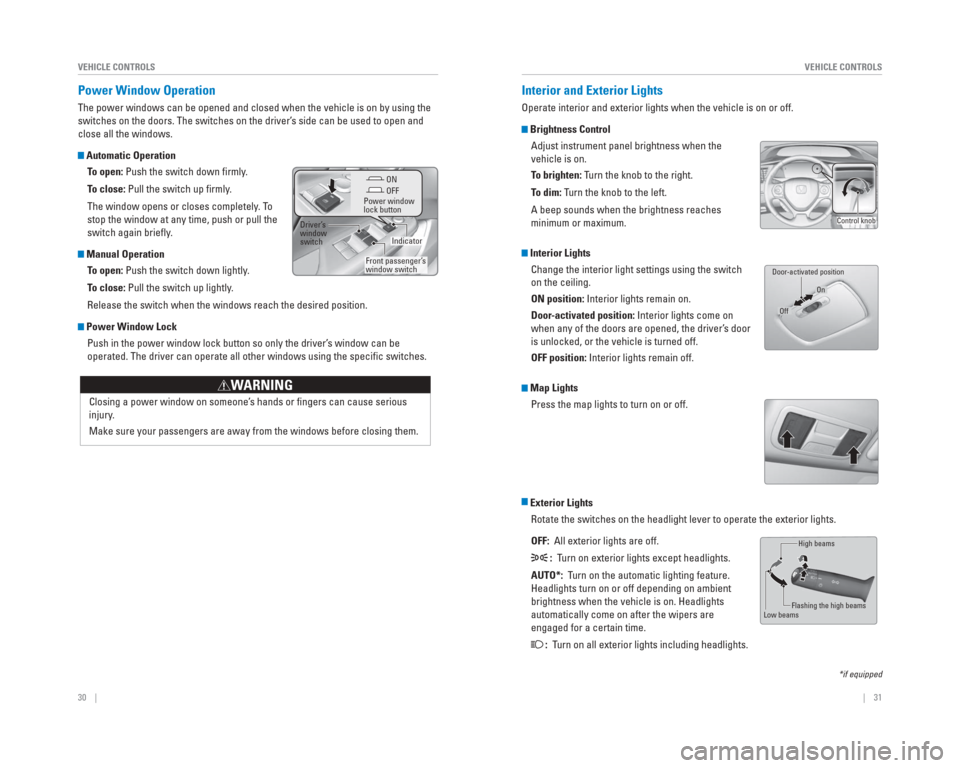
30 || 31
VEHICLE CONTROLS
VEHICLE CONTROLS
Power Window Operation
The power windows can be opened and closed when the vehicle is on by usi\
ng the
switches on the doors. The switches on the driver’s side can be used to open and
close all the windows.
Automatic Operation
To open: Push the switch down fi rmly.
To close: Pull the switch up fi rmly.
The window opens or closes completely. To
stop the window at any time, push or pull the
switch again briefl y.
Manual OperationTo open: Push the switch down lightly.
To close: Pull the switch up lightly.
Release the switch when the windows reach the desired position.
Power Window LockPush in the power window lock button so only the driver’s window can be
operated. The driver can operate all other windows using the specifi c switches.
OFF
Power window
lock button
Driver’ s
window
switch
Front passenger’ s
window switch ON
Indicator
Closing a power window on someone’
s hands or fi ngers can cause serious
injury .
Make sure your passengers are away from the windows before closing them.\
W ARNING
Interior and Exterior Lights
Operate interior and exterior lights when the vehicle is on or off.
Brightness Control
Adjust instrument panel brightness when the
vehicle is on.
To brighten: Turn the knob to the right.
To dim: Turn the knob to the left.
A beep sounds when the brightness reaches
minimum or maximum.
Interior LightsChange the interior light settings using the switch
on the ceiling.
ON position: Interior lights remain on.
Door-activated position: Interior lights come on
when any of the doors are opened, the driver’s door
is unlocked, or the vehicle is turned off.
OFF position: Interior lights remain off.
Map LightsPress the map lights to turn on or off.
Exterior LightsRotate the switches on the headlight lever to operate the exterior light\
s.
OFF: All exterior lights are off.
: Turn on exterior lights except headlights.
AUTO*: Turn on the automatic lighting feature.
Headlights turn on or off depending on ambient
brightness when the vehicle is on. Headlights
automatically come on after the wipers are
engaged for a certain time.
: Turn on all exterior lights including headlights.
Control knob
High beams
Low beams Flashing the high beams
On
Door
-activated position
Off
*if equipped
Page 20 of 65
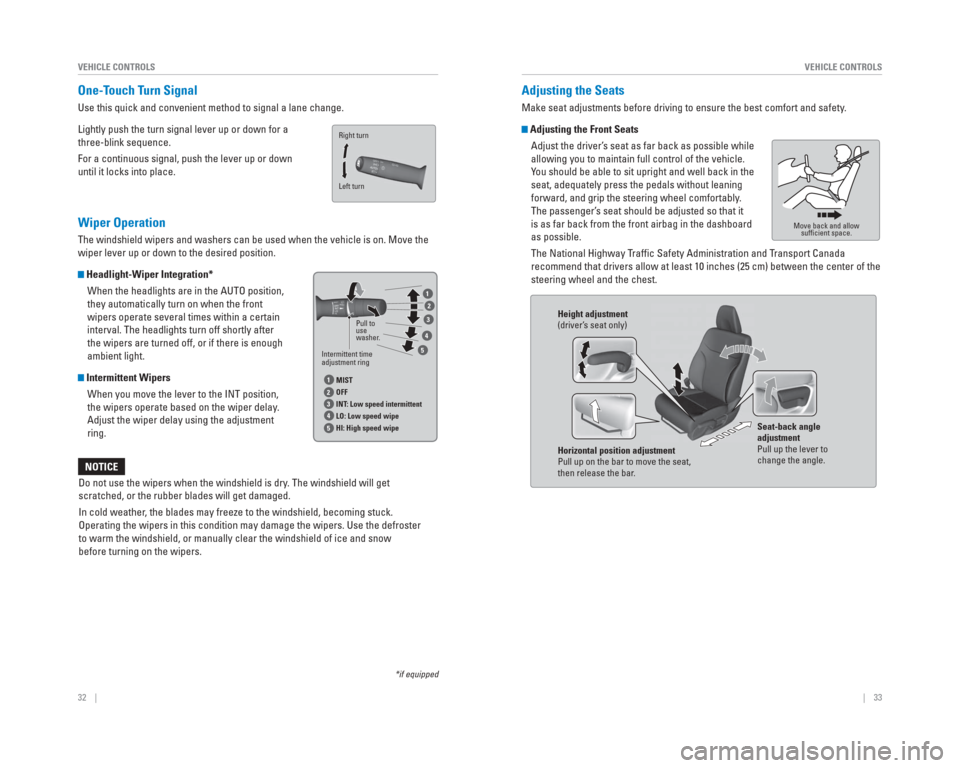
32 || 33
VEHICLE CONTROLS
VEHICLE CONTROLS
One-Touch Turn Signal
Use this quick and convenient method to signal a lane change.
Lightly push the turn signal lever up or down for a
three-blink sequence.
For a continuous signal, push the lever up or down
until it locks into place.
Wiper Operation
The windshield wipers and washers can be used when the vehicle is on. Mo\
ve the
wiper lever up or down to the desired position.
Headlight-Wiper Integration*
When the headlights are in the AUTO position,
they automatically turn on when the front
wipers operate several times within a certain
interval. The headlights turn off shortly after
the wipers are turned off, or if there is enough
ambient light.
Intermittent WipersWhen you move the lever to the INT position,
the wipers operate based on the wiper delay.
Adjust the wiper delay using the adjustment
ring.
Do not use the wipers when the windshield is dry. The windshield will get
scratched, or the rubber blades will get damaged.
In cold weather, the blades may freeze to the windshield, becoming stuck.
Operating the wipers in this condition may damage the wipers. Use the de\
froster
to warm the windshield, or manually clear the windshield of ice and snow\
before turning on the wipers.
NOTICE
*if equipped
Intermittent time
adjustment ring Pull to
use
washer
.
MIST
OFF
INT : Low speed intermittent
LO: Low speed wipe
HI: High speed wipe
1
1
2
2
3
3
4
4
5
5
Left turn Right turn
Adjusting the Seats
Make seat adjustments before driving to ensure the best comfort and safe\
ty .
Adjusting the Front Seats
Adjust the driver’s seat as far back as possible while
allowing you to maintain full control of the vehicle.
You should be able to sit upright and well back in the
seat, adequately press the pedals without leaning
forward, and grip the steering wheel comfortably.
The passenger’s seat should be adjusted so that it
is as far back from the front airbag in the dashboard
as possible.
The National Highway Traffi c Safety Administration and Transport Canada
recommend that drivers allow at least 10 inches (25 cm) between the ce\
nter of the
steering wheel and the chest.
Move back and allow suffi cient space.
Height adjustment
(driver’ s seat only)
Horizontal position adjustment
Pull up on the bar to move the seat,
then release the bar . Seat-back angle
adjustment
Pull up the lever to
change the angle.